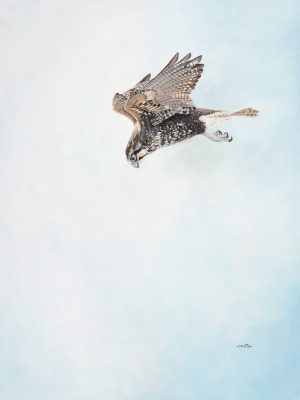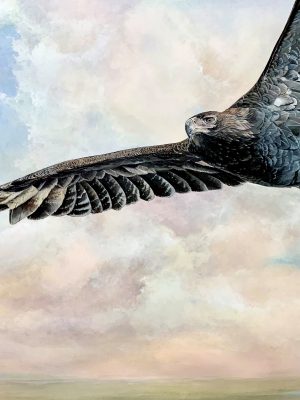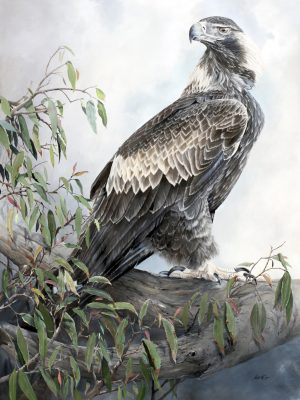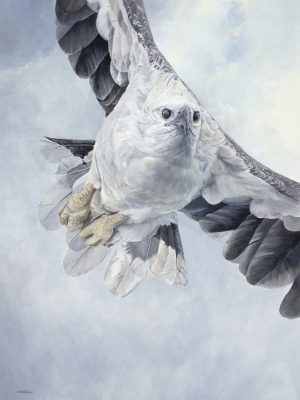Showing all 12 results

Grey goshawk - white morph (Accipiter novaehollandiae)
The grey morph has a pale grey head and back, dark wingtips, barred grey breast and tail, and white underparts. The white morph is the only bird of prey in the world to be entirely white.
Grey Goshawks are about 40–55 cm long, with wingspans of 70–110 cm. Females are much larger than males, weighing about 680 g. Males average 350 g.
Goshawks usually prey on mammals such as rabbits, possums, and bats. They may also eat birds, small reptiles, and insects. Females, due to their size, can catch larger prey than males.
Hunting is often done by stealth, and very successfully, but Grey Goshawks are willing to pursue their prey before catching it with their talons
This original piece is SOLD.

One of my favourite raptors. Usually around 40 cm to 50 cm long, they are found in light and dark forms and a variety of intermediates. They typically have red-brown heads with narrow black streaks with a light crown and off white chin. Wings are a spotted red-brown with dark brown quills. Beaks are light blue/grey, eyes are brown. The falcons make a loud cackle call uttered frequently. The brown falcon eats small mammals, including house mice and young rabbits. It also eats small birds, lizards, snakes and a variety of invertebrates particularly caterpillars, grasshoppers, crickets and beetles. Insects form the bulk of their diet during winter and the falcons often chase the insects on the ground!
(Sincere thanks once again to Clive Roper for his superb reference images)
This original piece is SOLD.

Tasmanian Masked Owls (Tyto novaehollandiae castonops)
Tasmanian Masked Owls are not only large, but robust. They weigh up to 1.26 kilograms with a wingspan of up to 129 centimetres. Their plumage is mainly a variable combination of browns and greys, generally darker than the other Australian subspecies. Females are considerably darker, as well as larger, than the males. They have broad, black-bordered, buff to chestnut facial discs, and fully feathered legs with powerful feet and long talons. The owls hunt at night, preying on a wide range of animals, from insects to mammals as large as rabbits, bandicoots and brushtail possums. (Sincere thanks once again to Dr Mehrdad Abbasian for his superb reference images)
Listed: Endangered.
This original piece is SOLD.

Tasmanian Wedge-tailed Eagle Nest (Aquila audax fleayi)
Wedge-tailed eagle nesting habitat is generally restricted to predominantly closed canopy old growth native forest, almost exclusively in tracts of tall eucalypt forest. Trees selected for nesting are among the largest in the locality, typically greater than 27 metres in height, with few exceptions. Nest trees normally occur on leeward slopes sheltered from prevailing strong winds.
The nest is a large structure of dead sticks, usually reused for years, often reaching considerable size. Nests 1.8 m across, 3 m deep and weighing about 400 kg are known. Nests have a shallow cup on the top, lined with fresh twigs and leaves. Sticks are added by a bird while it stands in the nest. If these sticks are dropped outside the nest, no effort is made to retrieve them. (With special thanks to Geoff ‘Hutcho’ Hutchinson for his fabulous reference images)
Listed: Endangered.
This original piece is SOLD.

This female Peregrine was successfully rehabilitated at the Raptor Refuge of Tasmania, Kettering. A joy to watch and a very good news story.
The Peregrine Falcon is the embodiment of apex hunter; fastest animal in the world and master of the famous Peregrine ‘stoop’.
My portrait of Peregrine domesticity hopefully provides the viewer with a snapshot of another side to these magnificent raptors - that of protective maternal instinct and total commitment.
While the female incubates the eggs and the chicks newly hatched the family unit is fed on the nest by the male, hence her expression …’You’re Late’
(My sincere thanks to Luke O’Brien for his superb reference images)
Award of Excellence - Holmes Art Prize for Australian Bird Art, QLD 2021
This original piece is SOLD. To view available limited edition prints, please click here.
Please get in contact for more information.

Tasmanian Wedge-tailed eagle (Aquila audax fleayi), Gravelly Beach, Tasmania
Watercolour and gouache on 640 gsm hot press rag paper - 100 cms x 120 cms.
The Wedge-tailed Eagle has long wings (wingspan 2.3 m), a characteristic long, wedge-shaped tail, and legs that are feathered all the way to the base of the toes. The bill is pale pink to cream, the eye brown to dark brown, and the feet off-white. Young Wedge-tailed Eagles are mid brown in colour with reddish-brown heads and wings. They become progressively blacker for at least the first ten years of their lives; adults are mostly dark blackish-brown. The only difference in plumage between the sexes is that a female adult is generally slightly paler than her mate. Females (4.2 kg - 5.3 kg) are also larger and heavier than males (3.2 kg up to 4.0 kg). Wedge-tailed Eagles are Australia's largest raptors (birds of prey). The Tasmanian subspecies (Aquila audax fleayi) is listed federally as endangered.
This original piece is SOLD. TO view available limited edition prints, please click here.
Please get in contact for more information.
110 cm x 90 cm Graphite on 640 gsm hot press rag paper
The Aberdeen Angus, sometimes simply Angus, is a Scottish breed of small beef cattle. It derives from cattle native to the counties of Aberdeenshire and Angus in north-eastern Scotland. Angus cattle were first introduced to Tasmania (then known as Van Diemen's Land) in the 1820s and to the southern mainland in 1840. The breed is now found in all Australian states and territories, including King Island. With lush pastures and a temperate climate, the island is perfect for breeding the happiest, grass-fed cattle on the planet.
This original piece is SOLD. To view our limited edition prints click here.

Juvenile Tasmanian Wedge-tailed eagle, watercolour and gouache. 110 cms x 80 cms on 640 gsm hot press rag paper
The endangered Wedge-tailed Eagle subspecies Aquila audax fleayi occurs only in Tasmania. It is distinguished by its size (being Australia's largest bird of prey) and wedge-shaped tail. The total adult population has been estimated as less than 1000 birds. Principal threats include loss of nesting habitat, nest disturbance, collisions (with artificial structures, vehicles and aircraft), electrocution and persecution.
Aquila is a beloved member of The Raptor Refuge Inc. which is a not-for-profit organisation dedicated to caring and protecting Tasmania’s natural wildlife. https://www.raptorrefuge.com.au/
This original piece is SOLD.

Cape Raoul, southern Tasmania
Watercolour and gouache on 640 gsm hot press Lana rag paper - H120 cms x W 150 cms. Framed
The Short-tailed Shearwater (Ardenna tenuirostris) is Australia’s most numerous seabird. During breeding season, millions converge on many small islands around southern Australia, with their stronghold in Bass Strait. Cape Raoul is at the southernmost tip of the Tasman Peninsula in Tasmania. The cape features rock platforms, towering 300 metre cliffs, columns and off-shore islands.
This original piece is SOLD
Please get in contact for more information.

Final Approach - White-bellied sea eagle
Watercolour gouache on 640gsm hot-press rag paper
Few Australian birds of prey are as spectacular as the White-bellied sea-eagle (Haliaeetus leucogaster). The White-bellied sea eagle is a large raptor that has long, broad wings and a short, wedge-shaped tail. It measures approximately 80 cm in length, and has a wingspan of 180–220 cm. Females weigh between 3-4.5 kg, and are larger than the males, which weigh between 2.5 and 3.7 kg.
This original piece is SOLD

Watercolour gouache on 640gsm hot-press rag paper
The yellow-tailed black cockatoo (Calyptorhynchus funereus) is a large cockatoo native to the south-east of Australia measuring 55–65 cm (22–26 in) in length. Two subspecies are recognised, although Tasmanian and southern mainland populations of the southern subspecies xanthanotus may be distinct enough from each other to bring the total to three. It is a highly charismatic species with complex social behaviours making it well-loved amongst nature lovers.
This original piece is SOLD. To view it as a limited edition print, click here.

Graphite 1.2 metres x 2.5 metres
Humpback whale and calf (Megaptera novaeangliae)
Humpback whales are a baleen whale and are renowned for their spectacular 'breaching' behaviour. Most humpback whales make exceptionally long journeys every year between their feeding and breeding sites. Females typically breed every two or three years. The gestation period is 11.5 months. The peak months for birth are January, February (Northern Hemisphere), July and August (Southern Hemisphere). Females wait for one to two years before breeding again. Humpbacks can travel up to 8 km/h but during their long migration journey they average only 1.6km/h, resting and socialising along the way.
This original piece is SOLD.
